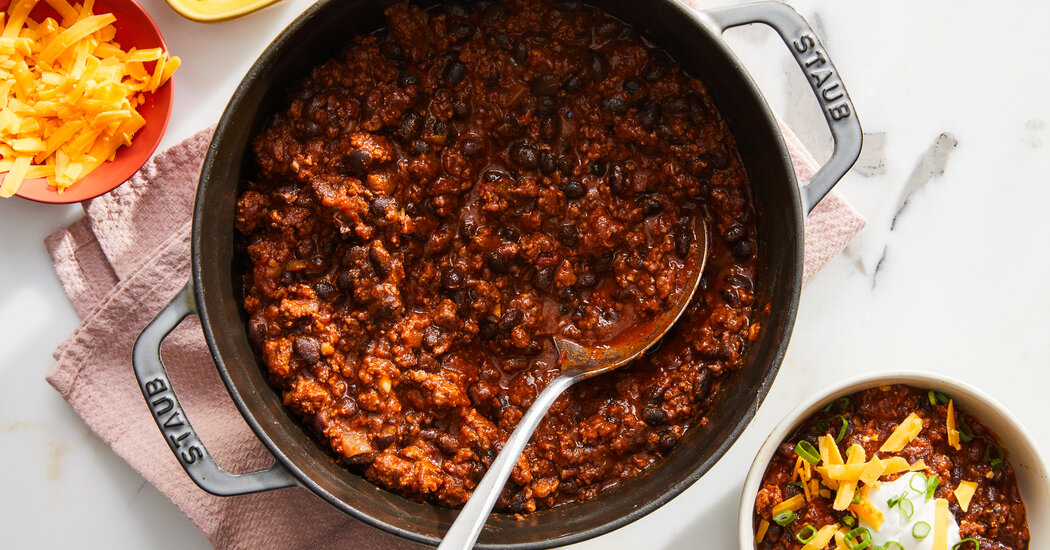Many will make chili (above) today, one of the great foods of National Football League cuisine, up there with wings and nachos. Ali Slagle’s recipe is top-drawer: deep in flavor, spice and smokiness, and fairly easy to prepare. I like to make it with coarsely ground beef from the butcher instead of the more finely cut stuff you get at the supermarket, but that’s just me being fancy. Make it with whatever meat you like — so long as it’s decently fatty, to bring out the taste of the aromatics. Chili’s a good way to guarantee a win during the Super Bowl, whichever team you’re rooting for.
Featured Recipe
Chili
But I had the good fortune to run into the Jamaica-born chef Darian Bryan the other day, and we fell into a discussion of oxtail stew that led me to make the dish that very night, and to think it’d be perfect championship fare today. I learned to stew oxtails from Velma Hawthorne, the executive chef of the Golden Krust Caribbean Bakery & Grill in New York, who builds the stew on a foundation of burnt sugar, or browning sauce. It is fantastic, but the process can be hell on a pot. Bryan laughed when I said that and told me it was just fine to substitute a commercial browning sauce instead — something like Kitchen Bouquet, available in most grocery stores. I did and the result was transcendent.
As for the rest of the week. …
Monday
You don’t need a proper recipe to make my bulgogi-style tofu, just some gochujang, ssamjang and a bunch of pantry staples, plus some lettuce for wrapping the crisp bits of fiery tofu and a bowl of rice. But don’t take my word for it. Here’s a note Marissa, a reader, left below my instructions: “The tofu was crisp and the flavor divine. Definitely a new favorite.”
Tuesday
Ali Slagle’s recipe for crispy baked fish with tartar sauce is an easy winter weeknight trip to a summer seafood shack, with a shattery crust; tangy, moist flesh; and no need for a big pot of oil. It’s sheet-pan cooking at its finest.
Wednesday
I love Nigella Lawson’s recipe for roast pumpkin, radicchio and feta salad, though truth be told I generally make it with butternut squash in place of the pumpkin. Would sweet potato work just as well? It would, and that would be a very fine meal.
Thursday
“Easy” chicken noodle soups often rely on shards of leftover roast chicken, or a torn-up rotisserie bird. But Alexa Weibel’s recipe begins with sautéed ground chicken instead, which makes for a far more complex and satisfying base. You’ll be ready to eat in 30 minutes.
Friday
Then you can head into the weekend with a sort of feast: the recipe for roast pork with milk that Pierre Franey helped Bryan Miller bring to life in the late 1980s, a memory of Miller’s taken from the kitchen of Adrienne Biasin, who for years ran the bistro Chez la Vieille in Paris. It’s luscious.
Thousands and thousands (and thousands!) more recipes are waiting for you on New York Times Cooking, though you need a subscription to read them. Subscriptions are important. They support our work and allow it to continue. If you haven’t taken one out yet, I’d like to ask if you would consider doing so today. Thanks.
We are standing by, should you find yourself in trouble with our technology. Just write for help: cookingcare@nytimes.com. Someone will get back to you. Or if you’d like to yell about something, or cheer our efforts, you can write to me: foodeditor@nytimes.com. I wish I could respond to every letter. But I read every one I get.
Now, it’s a far cry from anything to do with victuals or the price of tea, but Tim Brinkhof has a fascinating story in Smithsonian Magazine about how Dutch painters depicted the extreme weather of the Little Ice Age, which ran from roughly 1250 to 1860.
Celebrity profiles — can’t stop, won’t stop. Here’s Simone Biles in Vanity Fair, by Leah Faye Cooper.
In case you missed it, I commend to you this article by Alex Vadukul for The New York Times about the restaurateur Keith McNally’s resurfacing of his 1990 film, “End of the Night,” at a theater in New York. Anyone who showed ticket stubs from a screening got half-price dinners at his establishments.







